(95-1) 8 398 433, 8 398 455
uatours@uniqueasiatravel.com

Inlay Lake
Inlay Lake, the jewel of Shan State, is located about 30 km to the south of Taunggyi. The Lake stretches 11 miles (17.7km) in the Nyaungshwe basin of southern Shan State at an altitude of 2918ft (889m)above sea level and studded with floating islands. The Lake ringed with mountain ranges and like the home to the Inthar national race. Many of whom live in stilted houses built over the water, which is only 20ft (6m) at its deepest. They grow vegetables on floating islands. Inlay Lake is famous for its scenic beauty and the unique leg-rowing of the Inthas, the native lake dwellers.
Getting there to Inle
The best option is to take a flight from Yangon to Heho, which is the nearest airport to the Lake. There are daily flights to Heho, which takes about an hour from Yangon. There also have flights from Mandalay and Bagan to get there. Another option is to take express bus from Yangon, which takes around 15-18 hours, and also have daily express buses from Mandalay. You can also have a train from Yangon to Shwe Nyaung Station interchange via Thazi Junction.
Interesting sights around the Lake
Phaung Daw Oo Pagoda
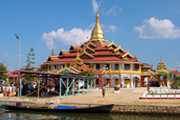 Devotees have covered the five images countless thousands of times with gold leaf, transforming them into round, golden lumps. It is one of the famous principal shrines in Myanmar. Once a year, in end September or early October, there is a pagoda festival during which the four Buddha images are rowed around the Lake in a colourful barge.
Devotees have covered the five images countless thousands of times with gold leaf, transforming them into round, golden lumps. It is one of the famous principal shrines in Myanmar. Once a year, in end September or early October, there is a pagoda festival during which the four Buddha images are rowed around the Lake in a colourful barge.
There are shops on the lower level of the shrine selling Shan fabrics and lacquerware. As its name suggests, the Five Day Market takes place every five days, making a round of the villages. This is not to be missed and provides opportunities to see members of national races, such as Danu, Pa O and Palaung, coming to trade.
Nga Phe Chaung Monastery
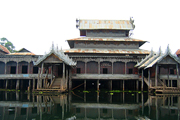 Nga Phe Chaung Monastery is located in Inlay Lake, on the way to Phaung Daw Oo Pagoda. This is an attractive wooden monastery built on stilts over the lake at the end of the 1850s. Aside from its collection of Buddhas the monastery may be of interest to visit because its monks have taught a few of the many cats living with them to jump through hoops. Boat ride to visit and ancient monastery built on huge pieces of teak wood with traditional architecture and see the popular jumping cats leap through the hoops.
Nga Phe Chaung Monastery is located in Inlay Lake, on the way to Phaung Daw Oo Pagoda. This is an attractive wooden monastery built on stilts over the lake at the end of the 1850s. Aside from its collection of Buddhas the monastery may be of interest to visit because its monks have taught a few of the many cats living with them to jump through hoops. Boat ride to visit and ancient monastery built on huge pieces of teak wood with traditional architecture and see the popular jumping cats leap through the hoops.
Mine Thauk Market
A large and bustling market where one can find a real local atmosphere with a variety of products from the Lake.
Indain Pagoda complex
Indein is one of the small villages of Inlay Lake located on the western bank of the Inle lake. A Buddha image has enshrined at a whitewashed stupa, which is on the summit of a hill. Below the stupa around the hill are hundreds of ancient stupas, which most are ruins overgrown with bushes. The hill where pagoda located is quiet and calm.
This mysterious place is at the end of the marvellous Indein creek, which connected with Inlay Lake just after the Phaung Daw Oo Pagoda. The creek is narrow with many twist and turns. Since the both sides are paddy fields you can see the farmers ploughing and harrowing by water buffaloes.
Taung To Pagoda Complex
Taung To Village has a pagoda complex smaller than its contemporary Indain but no less beautiful. It lies further south on the west bank.
Sagar
Sagar is a ruined royal capital with ancient monasteries and pagodas at the southern end of Inle Lake, in a beautiful, isolated setting far from villages.
Other interesting sites around the Lake
Silver smith ateliers and silk or lotus weaving cottage industries are among the most fascination attractions in the area. The hand-woven silks are lustrous in all colours of the rainbow, the silver work is delicate and the fabric woven of fibres taken from lotus stems are not found anywhere. There is also a pottery village of Kyaut Taing, making thin glazed wares in shining blacks and earth-reds.
You can also enjoy bathing at hot water spring near Khaung Daing Village.
Pindaya Caves
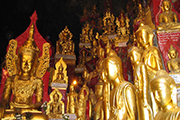 The three caves along the cliff are believed to contain more than 8,000 images. The caves are set deep in the hillsides and there stands at the entrance, a 15 meter high Shwe U Min Pagoda.
The three caves along the cliff are believed to contain more than 8,000 images. The caves are set deep in the hillsides and there stands at the entrance, a 15 meter high Shwe U Min Pagoda.
Here one can see many Buddha images in the ‘healing’ posture, with a bowl on the upturned palm of the left hand while the forefinger and thumb of the right hand holds a fruit called hpan khar (Terminalia chebula), which is often used in traditional medicine.
Taunggyi
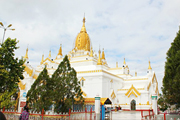 Taunggyi, over 1430 metres above sea-level, is the capital of Shan State. It is a hill station, cool and pleasant all the year round. The market, on every fifth day, is crowded with ethnic minorities in their traditional dresses. It is also like the trade center of the southern Shan State.
Taunggyi, over 1430 metres above sea-level, is the capital of Shan State. It is a hill station, cool and pleasant all the year round. The market, on every fifth day, is crowded with ethnic minorities in their traditional dresses. It is also like the trade center of the southern Shan State.
Kekku Pagoda Complex
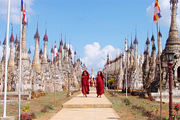 Hidden for centuries in the wooded hills near Taunggyi, the Kekku Pagoda Complex has pagodas that seem to be from the 16th century. This is the main shrine of the region’s Pa O national race, who grow the best garlic in the country. Pa O legends say there are 7,622 pagodas, almost all decorated with floral designs or figures of celestial beings or birdmen.
Hidden for centuries in the wooded hills near Taunggyi, the Kekku Pagoda Complex has pagodas that seem to be from the 16th century. This is the main shrine of the region’s Pa O national race, who grow the best garlic in the country. Pa O legends say there are 7,622 pagodas, almost all decorated with floral designs or figures of celestial beings or birdmen.
Kalaw
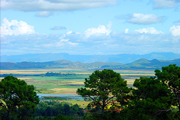 Kalaw is another hill station, located 1400 metres above sea-level. Many of the Tudor-style houses and English gardens of colonial days remain. It located at 70 km west of Taunggyi. The cool climate of the hill station is perfect for flowers and in spring and summer, the roads are lined with thickly flowering crocus.
Kalaw is another hill station, located 1400 metres above sea-level. Many of the Tudor-style houses and English gardens of colonial days remain. It located at 70 km west of Taunggyi. The cool climate of the hill station is perfect for flowers and in spring and summer, the roads are lined with thickly flowering crocus.
Hnee Paya Pagoda (Bamboo Image)
This large sitting image in Kalaw was made in an old, almost forgotten technique in which strips of bamboo are woven to form the shape and covered with cloth dipped in lacquer. The image was then gilded with real gold.
Nyaungshwe
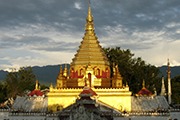 Nyaungshwe is the gateway to Inlay, almost halfway between Heho and kalaw. The town has a huge market where local produce is sold.
Nyaungshwe is the gateway to Inlay, almost halfway between Heho and kalaw. The town has a huge market where local produce is sold.
Shwe Yan Pyay Kyaung
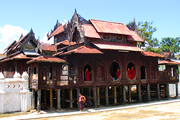 The monastery located just outside Nyaungshwe, built with a fascinating wooden monastery on early 19th century. The architecture has traditional motifs such as oval windows and tiered roofs. The interior has exquisite glass mosaic work and panels richly gilded with pure gold leaf.
The monastery located just outside Nyaungshwe, built with a fascinating wooden monastery on early 19th century. The architecture has traditional motifs such as oval windows and tiered roofs. The interior has exquisite glass mosaic work and panels richly gilded with pure gold leaf.
Contact Us
No.152, Sule Pagoda Road, Kyauktada Township, Yangon, Myanmar.
(95-1) 8 398 433, 8 398 455, 8 398 499
24hrs hotline : (95-9) 540 2525, 540 2727, 540 2929
